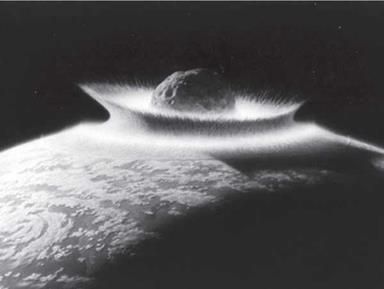Robert Burnham points out that it was not until the Space Age that astronomers realized just how pervasive cometary and asteroid impacts are throughout the Solar System. Beyond the Moon’s cratered and craggy surface, NASA’s planetary science missions have charted numerous bodies in our star system riddled with impact craters. Those missions reveal, explains Burnham, “that by an overwhelming margin the most common feature in the Solar System is the impact crater. Entire planets, moons, and asteroids turned out to be covered with them, at all scales ranging from global to microscopic. Craters or their traces can be found on every solid surface from Mercury to Pluto and surely beyond.”39 It’s likely the object that devastated the Siberian taiga near the Stony Tunguska River at approximately 7:15 a. m. on June 30, 1908, was a meteorite. However, the unknown projectile was not made of iron like the meteorite that excavated Meteor Crater in Arizona approximately 50,000 years ago. It is estimated the impactor exploded above ground with the force of 1,000 atomic bombs, more than adequate to destroy a modern city. The explosion reportedly flattened 830 square miles of forest, leveling 30 million trees, and was heard 500 miles away. Multiple remarkable witness accounts of this event included a man, 40 miles from the impact site, who reported being knocked off his feet by a searing blast wave.40 Atmospheric pressure waves registered on barographs after racing around the world at hundreds of miles per hour. The explosion apparently caused a local geomagnetic storm that lasted for days. People in London wondered about the strange, glowing atmospheric effects and pink-fringed clouds appearing in evening skies. One British meteor specialist published his observations in Nature in 1908, saying that the night sky over Bristol, England, was so bright few stars could be seen.41
In July 1994, Comet Shoemaker-Levy 9 broke into fragments that subsequently slammed into Jupiter with an estimated explosive force of six hundred times humanity’s entire nuclear arsenal, and spewed plumes of material thousands of miles above Jupiter’s clouds. Millions globally, including astronomers, world leaders and politicians, and a fascinated public, found themselves captivated by television news reports and images streaming from JPL’s designated website. That single comet impact raised global awareness of the very real danger such events pose for Earth’s populations (figure 6.4). The comet began to impact Jupiter on July 16. Within three days, the U. S. House Committee on Science and Technology voted to establish a NASA program to track comets and asteroids that could threaten the Earth. As co-discoverer of the comet David Levy recalls, “This vote reflected the nation’s fascination, and its growing awareness that such a trail of destruction could have been headed at Earth. The initiative was designed to protect future generations of people.” Should the threat of a comet or an asteroid impact be successfully deflected, Levy contends the global attention focused on Comet Shoemaker-Levy will have in effect “rescued our planet.”42
Though the devastation of comet impacts is obvious, these primordial snowballs may very likely be the reason for life on Earth. Given their ubiquity, it’s believed that cometary impacts are a common vector by which life may have emerged on Earth. As noted previously, researchers working with the Stardust data reported finding the amino acid glycine in Comet Wild 2 samples. Amino acids are comprised of what is commonly referred to as CHON, or carbon, hydrogen, oxygen, and nitrogen atoms, and the molecules that CHON, along with phosphorus and sulfur, can combine to
|

Figure 6.4. Comets are carriers of both life and death. This artist’s impression shows a large comet impact on the early Earth. Cometary material includes water that led to the Earth’s oceans and some basic building blocks of life like amino acids, but occasionally impacts by comets have caused devastation and destruction over the Earth’s history, including several mass extinctions in the past half billion years (NASA/Don Davis).
|
make are all chemical ingredients of DNA. Comet and meteorite impacts on Earth could have dispersed such organics or even synthesized them.43
Science writer Connie Barlow claims: “Our ancestors include ancient stars. Stars are part of our genealogy.”44 She means that if we want to discover our origins, we can’t simply peer into a microscope at possible progenitor organisms. Instead, we need to look to the stars, where heavy elements necessary for life, like carbon, are forged. But we also can attribute our genetic makeup to comets and asteroids that may have deposited on Earth the chemistry for life. All known organisms are the products of their DNA, and some components of DNA have been detected in meteorites. In 2011, NASA scientists reported finding in meteorites “adenine and guanine, two of the four so-called nucleobases that, along with cytosine and thymine, form the rungs of DNA’s ladder-like struc – ture.”45 DNA is the coded information in our cells that determines biologically who and what we are. “At the center of the ladder-like DNA molecule lie ring-like structures called nucleobases. It’s these tiny rings that scientists at NASA and the Carnegie Institution for Science in Washington found in 11 of 12 meteorites they scrutinized.”46 Meteorites, if not jettisoned from a neighboring planet, are remnant chunks of rocky debris left over from the Sun’s formation. Given that such meteorites deliver organic molecules to Earth, molecules from our star’s earliest days are inevitably in our DNA. Scientists reported in the journal Nature having found fossils of multicellular life dating back 2.1 billion years, roughly 1.5 billion years prior to the Cambrian explosion. These fossils in black shales in West Africa rewrite the history of when multicellular organisms first emerged.47 Microbial life on Earth predates even this. Biologists, astronomers, and astrobiologists now faced with recalibrating the timescales on which life began on Earth are reworking our appreciation for comets and their critical role in dispersing stardust throughout the Solar System.
Stardust’s mission to capture the interplanetary dust grains that pervade our star system is an attempt to understand not only how our Sun originated and evolved, but also the characteristics of the early Solar System that led to the origin of life. What we learned from the Stardust mission is that comets and asteroids harbor the building blocks of life. Twenty different amino acids, occurring naturally in a wide number of arrangements, produce the proteins that create all living organisms on Earth. John and Mary Gribbin report, “Formic acid (the stuff some ants squirt out as a defensive weapon, and the stinging ingredient in stinging nettles) and metha – nimine are two of the polyatomic organic molecules that have been identified in dense interstellar clouds. Together, they combine to form an amino acid, glycine.”48 As James Lovelock, originator of Gaia Theory, has observed, “It seems almost as if our Galaxy were a giant warehouse containing the spare parts needed for life.”49 Perhaps the universe is built for life. The Gribbins suggest that the chemistry for life is endemic to the entire universe. They assert that “one of the most profound discoveries made by science in the twentieth century” is that the universe comprises “the raw materials for life, and that these raw materials are the inevitable product of the processes of star birth and star death.”50
Though the normal matter that makes up stars, planets, and stellar dust clouds constitutes only a small fraction of the total matter in the universe, most of which is dark and still mysterious, the stuff of stars nevertheless provides all the components necessary for life. “The raw material from which the first living molecules were assembled on Earth was brought down to the surface of the Earth in tiny grains of interplanetary material, preserved in the frozen hearts of comets,” write Gribbin and Gribbin, who eloquently observe, “Those grains themselves literally, not metaphorically, formed from material ejected by stars. The ‘manna from heaven’ that carried the precursors of life down to the surface of the Earth was literally, not metaphorically, stardust. And so are we.”51 That we are made of stardust is not to be disparaged. It’s likely that life has emerged on planets orbiting other stars in galaxies far, far away. If so, it’s certain that the blood in their veins and the calcium in their bones, should they have them, were forged in the fires of their suns.













